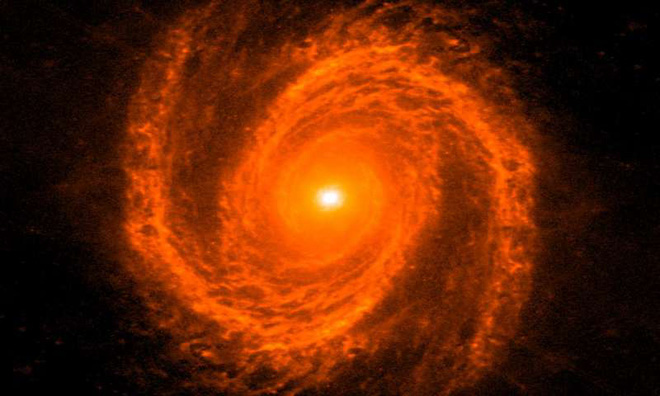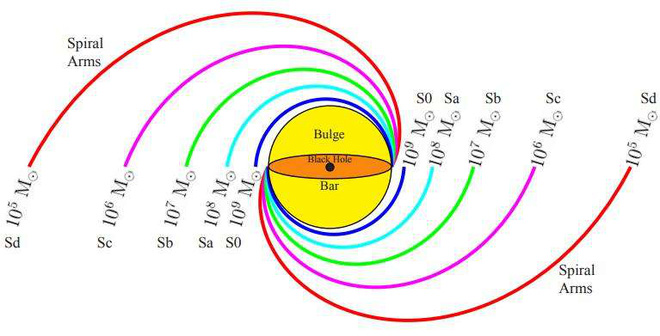Find out how to weigh black holes based on galaxy spiral arms
With this calculation, from astronomers to students can calculate the mass of the black hole.
- 10 interesting facts about black holes in the universe (Part 1)
- 10 interesting facts about black holes in the universe (Part 2)
- Discovering new gravitational waves from two black holes collides 3 billion light-years away
Astronomers from the University of Minnesota Duluth, USA and Swinburne University of Technology, Australia have discovered a black hole "weight" method at the center of the galaxy by looking at a spiral branch of it.

Black holes never emit recognizable light. Therefore, astronomers often study black holes through stars and atmospheres around their orbits. Since then, they have given a reasonable measure of how big the black hole is.
Based on previous measures, scientists have found that the mass of black holes can be estimated simply by observing its host galaxy spiral arms.
Spiral galaxies are a type of galaxy with spiral arms, usually two branches. The spiral galaxies contain a flat, rotating disk containing stars, gas, dust and bulges, the area that gathers many stars at the center of the galaxy. The spiral arms of the galaxy extend from the center to the disk.
Nearly a decade ago, Professor Marc Seigar at the University of Minnesota Duluth, co-author of this study, discovered the relationship between the mass of the central black hole and the tight density of the twisted branches. a galaxy.

Spiral Galaxy Messier 81, located on the northern constellation of Ursa Big, and has a mass of black holes about 68 million times the sun.
Scientists have relied on it to carry out new research and discover an unexpectedly strong connection between mass black holes and spiral branch geometry. At the same time, they also predict that lower mass black holes in the galaxy will have open spiral arms.
The power of this relationship makes it possible for anyone to assess how black the hole behind a large spiral galaxy looks at its image. This is a better method than any other method used to predict the previous black hole mass.

By looking at the different levels of tightness of the spiral arms, the masses of the central black hole and the corresponding galaxy in the mass units of the galaxy estimate the masses of black holes in the spiral galaxy.
This method also allows to predict the mass of black holes in pure galaxies with bulging segments filled with constellations.
Based on the relationship between black hole mass and spiral branch geometry, scientists can also study medium mass black hole communities (about 100 to 100,000 times larger than the sun), losing calculus at the present time. They have a much larger mass than any single star, but are smaller than huge black holes and billions of times heavier than our Sun.
You should read it
- 10 interesting facts about black holes in the universe (Part 1)
- A new discovery about the strange interaction between cosmic black holes and light
- Detecting monstrous black holes, 20 billion times larger than the sun and growing 'fast'
- Hubble begins its hunt for hard-to-identify medium-sized black holes
- Discover the most bizarre black holes in the mysterious space universe
- The discovery of a giant black hole, 70 times the mass of the Sun in the Milky Way, challenges every theory
- Discover the terrible war between two giant black holes in the universe
- Successfully creating cosmic black holes, demonstrating Hawking radiation exists
- Our galaxy contains countless invisible black holes?
- 10 interesting facts about black holes in the universe (Part 2)
- Discovering new gravitational waves from two black holes collides 3 billion light-years away
- If people fall into a black hole, what horrors will await them?
May be interested

Listen to the strange sound obtained from planets in the Solar System

Is there a way to destroy and destroy a cosmic black hole?

After 40 years of searching, scientists have discovered the type of wave that reveals the secret of the Sun's core

The world's largest virtual universe created by Chinese supercomputers

The original black hole in the universe can produce gold and uranium

Discovering two 'super-Earths' only 12 light-years away can hide life






 10 interesting facts about black holes in the universe (Part 1)
10 interesting facts about black holes in the universe (Part 1) Discover the terrible war between two giant black holes in the universe
Discover the terrible war between two giant black holes in the universe The discovery of a giant black hole, 70 times the mass of the Sun in the Milky Way, challenges every theory
The discovery of a giant black hole, 70 times the mass of the Sun in the Milky Way, challenges every theory The newly discovered black hole contains anomalous characteristics, challenging most astronomical theories today
The newly discovered black hole contains anomalous characteristics, challenging most astronomical theories today Our galaxy contains countless invisible black holes?
Our galaxy contains countless invisible black holes? Shocking discovery in astronomy: 3 supermassive black holes in the same galaxy
Shocking discovery in astronomy: 3 supermassive black holes in the same galaxy